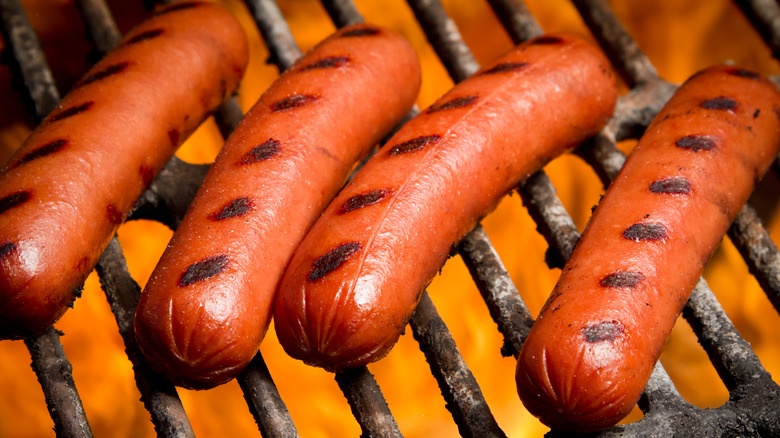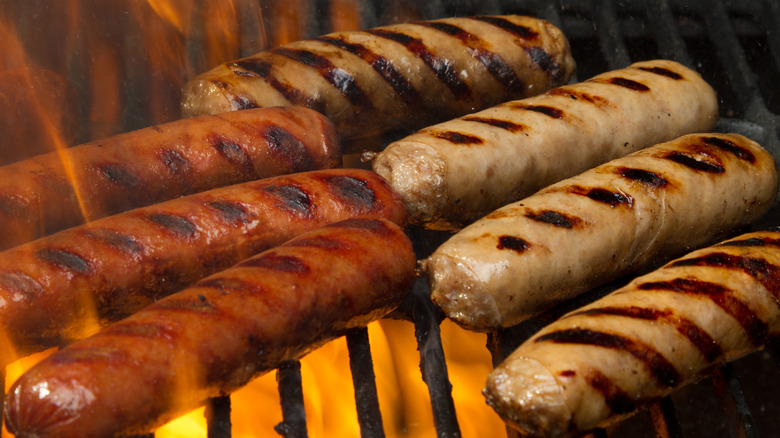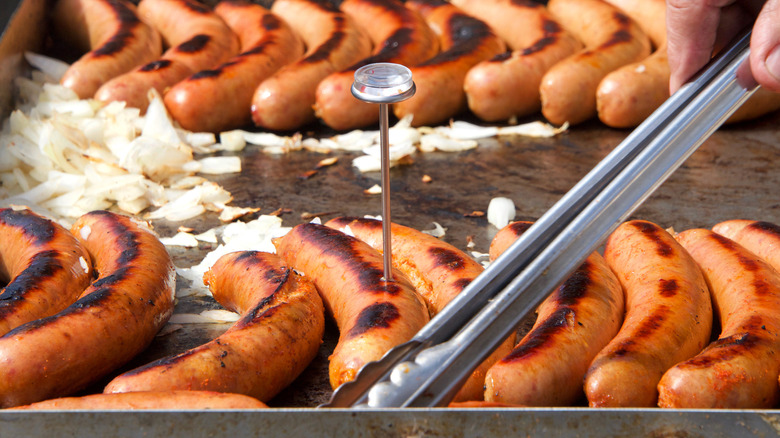Why You Should Consider Fat Content Before Grilling Hot Dogs
Cooking hot dogs on the grill might seem straightforward, but achieving the perfect balance of smoky flavor and juicy texture requires a bit of finesse. While cranking up the heat can lead to those classic grill marks, it often results in a dog that's charred on the outside and dangerously rare on the inside. But what's the right amount of heat and how long should you cook a hot dog for the perfect flavor and texture? It turns out there's not one answer. The optimal time and temperature depend on what the hot dog is made of, its size, and, most importantly, how much fat it contains.
Grilling expert, Julie Busha, the creator of Slawsa which was featured on Shark Tank, urges novice chefs to take fat content into account when grilling hot dogs. "Higher-fat dogs should be cooked at a medium heat whereas leaner dogs should be grilling on a medium-low setting," she told Insider.
A one-size-fits-all model doesn't work for all hot dogs because there are so many different kinds with varying fat content. 100% beef and pork dogs tend to contain more fat than those made of poultry or vegetarian ingredients, which can keep them jucier on the grill. Leaner hot dogs, like chicken sausages, have a tendency to dry out, warn the experts at Char-Broil, so they must be cooked at a lower or indirect heat.
Deciding how to grill different hot dogs
Whether your hot dog is higher fat or not, the highest heat is not appropriate for any dog. Most chefs and grilling aficionados will agree that a two-zone method is right for grilling all types. Having a hot side and a cooler side of the grill will enable you to cook all types of hot dogs on the lower heat side and save the hotter side for grill marks only. This indirect heat will keep the leaner meats or vegetables in a low-fat hot dog from losing all of their moisture, it will also prevent the fat in a fattier dog from flaring up and burning the outside of it before the inside is cooked through.
If you look at a few different types of hot dogs side by side you'll see why fat content requires a different approach to each. A standard-size Nathan's hot dog with 12 grams of fat can handle a brief period on the hotter side of the grill. A moderate-fat hot dog like Applegate's The Great Organic Uncured Chicken Hot Dog, with 4.5 grams of fat, should be cooked through on moderate heat, according to the package. Veggie dogs like those from Morning Star Farms are remarkably low in fat and come with pre-existing grilled flavor and grill marks. To prevent burning they should cook on low heat and also be turned frequently.
Get a thermometer for the most accurate results
While knowing the fat content of a hot dog is crucial, cooking times can vary even among those that seem similar or are sold by the same brand. Nathan's, for example, has eight different hot dog products that range from the classic skinless beef frank with 130 calories and 12 grams of fat to the Colossal size with 350 calories and 32 grams of fat. Likewise, poultry and veggie dogs can vary greatly in composition and size. The only way to truly determine if your hot dog is done, and thus safe for consumption, is to use an instant-read thermometer.
When grilling meats that have already been cooked, like hot dogs, the CDC recommends hitting an internal temperature of 165 degrees Fahrenheit. And, after cooking, don't let the meats languish in the sun. You need to hold anything that has already been grilled at or above 140 degrees Fahrenheit to ensure that it's safe to eat. Also, be sure to refrigerate any leftovers no more than two hours after cooking.


